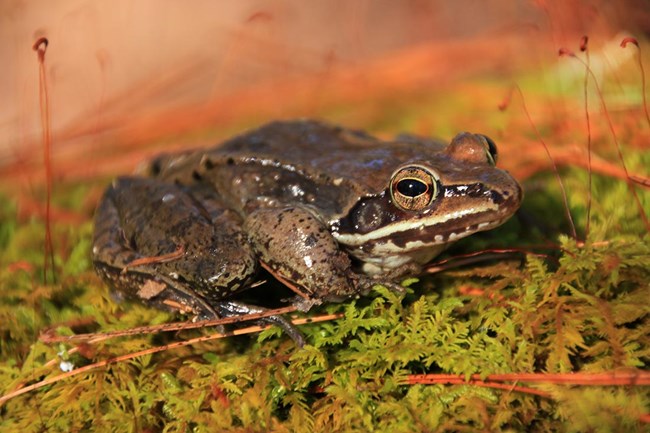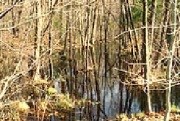
Warren Bielenberg photo The Southern Appalachians are considered the center of salamander diversity on earth and the Blue Ridge Parkway, which follows the high crests of the Southern Appalachian Mountains for 469 miles sits in the heart of this zone. The abundance of rain is probably the primary factor allowing for this richness. Whether laying their eggs, living in streams, or foraging under a rotting log, salamanders depend on water to survive. Water is essential for other amphibians as well. With the first warm rains in March wood frogs and spring peepers head to vernal pools to lay their eggs. Later bullfrogs, pickerel frogs and American toads will follow suit. By summer the Parkway is alive with the call of frogs. A growing body of evidence suggests that amphibians are highly sensitive to environmental disturbance, and are declining at rates that far exceed those of other vertebrate groups. These declines have been attributed to habitat alteration, gypsy moth defoliation, pollution from pesticides, acid precipitation, increased ultraviolet radiation due to depletion of the ozone layer, and global climate change. Parkway programs and management may have contributed to local amphibian declines. Early designers and landscape architects incorporated scenic agricultural landscapes as well as forested natural areas into the design of the Blue Ridge Parkway. Research has shown that forest fragmentation resulting from timbering, agricultural activities, development, roads and utility corridors can have adverse impacts on amphibian populations. Parkway biologists are working with local researchers and other land managers to determine ways to help our amphibian populations. Cattle are being fenced out of wetlands on Parkway agricultural leases. Trees cut under the hazard tree program are left lying in the woods to provide habitat rather than being hauled away. Parkway biologists are looking at disturbed wetland sites to determine if any can be restored and the return of beavers to the Southern Appalachians will provide additional amphibian sites. Download the parkway's Amphibian and Reptile Checklist 
Vernal Pools
The puddles are vernal pools, bodies of water ranging from as small as a closet up to several acres in size. “Vernal” refers to spring, and the majority of these pools are temporary, being filled with water for only a short time during the spring. For this reason, many people don’t really think of them as true wetlands, or as valuable parts of the ecosystem. However, they are critical breeding sites for many species of amphibians, including wood frogs and spotted salamanders. These species are terrestrial most of their lives, except for during the breeding season when they congregate in vernal pools. Wood frogs (Rana sylvatica) are generally out first in February and can be identified near the pools as their “quacking” calls are heard. They call, mate, and deposit egg masses. They are soon followed by the spotted salamander (Ambystoma maculatum), a member of the mole salamander family, which spends its adult life underground. Other species may use vernal pools, including American toads and spring peepers, but the wood frog and spotted salamander utilize vernal pools almost exclusively. The temporary nature of the vernal pool means that many species of predators, such as fish, will not survive the dry periods. This is a distinct advantage if you are looking for a nursery and don’t want your young eaten. However, in years of drought, the pool may not contain water at all, or may not sustain water long enough for the young to hatch and metamorphose into terrestrial forms. It is a gamble, with the payoff being a new generation of young. But even if the water dries up it is likely that the adults will probably live long enough to return next year and try again. A risk to the frogs and salamanders includes being run over by vehicles while crossing roads to get to vernal pools. Perhaps the greatest risk, however, comes from humans who fill in pools and who dig ditches to drain the pond. Such actions can lead to local “silent springs” without the familiar calls of our native frogs. |
Last updated: January 30, 2018
